May 26 - 31, 2006

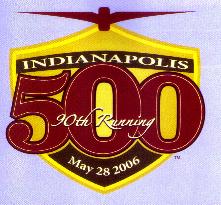
| Chicago & Indianapolis May 26 - 31, 2006 |
 |
 |
![]()
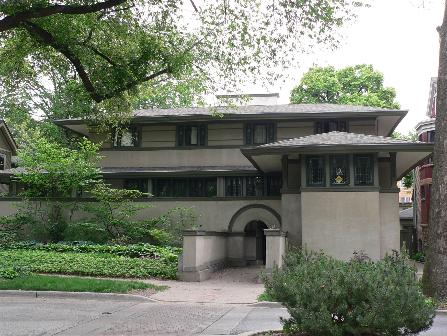 Oak Park: Frank W. Thomas House (1901) |
Our first day was spent in Oak Park Village, one of the first suburbs of Chicago who's claim to fame is 25 houses either designed or remodeled by the greatest American architect, Frank Lloyd Wright. After touring Wright's own Home and Studio, we took a guided walking tour around the neighborhood seeing about ten of Wright's houses as well as many other interesting houses. We saw the house where Ernest Hemingway was born and raised and a house built from a Sears, Roebuck & Co. kit. Back in the day, you could order almost anything from the Sears catalog. |
We ended up at Unity Temple, a really unusual church also designed by Wright and completed in 1908. It was a beautiful day in the neighborhood as Mr. Rogers used to say.
After walking around downtown Oak Park Village and indulging in a Ben & Jerry's ice cream cone, we drove by the Pleasant Home, a large Prairie-style mansion in Oak Park Village.
From Oak Park Village, we drove south to Jackson Park to see the Museum of Science and Industry building which is the only remaining building from the 1893 World's Columbian Exposition and the "Golden Lady" statue. Leaving Chicago, we drove about 120 miles (193 km) to our hotel in Lafayette, Indiana, home of Purdue University.
The next day we drove 60 miles (97 km) to Indianapolis. We had some time before the race so we walked around the downtown area. We saw the State House, the Soldiers' and Sailors' Monument and the Circle Tower, a great Art Deco building.
The Indianapolis Motor Speedway is actually located in Speedway, a suburb of Indianapolis and is mostly surrounded by residential areas. On our way to the speedway, we passed many houses where people were offering parking on their lawns ($10 - $20). There were also many lawn/tailgate parties going on with piles of empty beer cans signifying several days (I hope) of revelry. Traffic was slow but we finally made it to our parking lot near the speedway in plenty of time.
This was the 90th running of the Indianapolis 500. After Indy car racing split into two separate organizations (IRL and CART/Champcar) about 10 years ago, this race lost some of its popularity but it's making a big comeback. A few celebrities now own IRL teams including David Letterman and NBA Basketball player Carmelo Anthony. Gene Simmons of KISS is now involved with Indy marketing and wrote the new IRL theme song, I am Indy. Al Unser Jr. and Michael Andretti even came out of retirement to race this year. Michael's son, Marco Andretti who is only 19 was racing in his first Indy 500. I saw his proud grandpa, Mario Andretti race in the Grand Prix of Monaco way back in 1976.
After recognizing all the celebrities, military troops and former Indy 500 champs in attendance, seeing the F-16 flyover, hearing Florence Henderson sing God Bless America and Jim Nabors sing Back Home Again in Indiana, it was time for the big announcement, "Lady and Gentlemen, start your engines!" After the pace car driven by Lance Armstrong led the pack around several times, they were off and running.
|
There is nothing like the sound and smell of all 33 cars going by at over 200 miles an hour. Of course after the field gets spread out, it's hard to keep up with who is in what position. The cars go by so fast, you have a hard time seeing their numbers. Luckily, there was a status board and video screen directly across from where we were sitting which was about 30 rows up from the entrance to pit road just after turn four. |
 Indy 500: Tomas Schector's Day is Done |
There were about four crashes in the race and two happened right in front of us. Tomas Schector's car hit the wall coming out of turn four and then slammed in to the styrofoam protection that is placed at the entrance to pit road. While I was videotaping Schector's extrication, I heard a loud bang and saw a piece of his car go flying up over the protective fence and land about 40 feet (12 m) over and five rows higher than where we were sitting. Apparently, another car ran over the piece and flung it up into the crowd. It was pretty scary but we think everyone got out of the way in time. Thankfully, no one was seriously injured or killed in the race.
The ending was really exciting. Because of pit stops, with one lap to go, Marco Andretti passed his dad and they were one-two which would have been a dream finish. Sam Hornish Jr. had the faster car though (he started at the poll position) and first passed Michael Andretti and then passed Marco just before the checkered flag for the second-closest finish in Indy 500 history winning by just .0635 seconds.
There were over 300,000 people at the race. We were sweating out thunderstorms but we ending up only sweating. It was the second hottest race day at 88º F (31ºC) and about 90% humidity. Luckily we came prepared bringing all the essentials: water and Gatorade in a small ice chest, sun screen, seat cushions and ear plugs.
The crowd was a lot different than the NASCAR crowd we experienced at the Daytona 500 last year. I did not notice a single IRL driver tee shirt at this race while almost everyone at the Daytona 500 wore a tee shirt of their favorite driver or some kind of NASCAR hat or shirt.
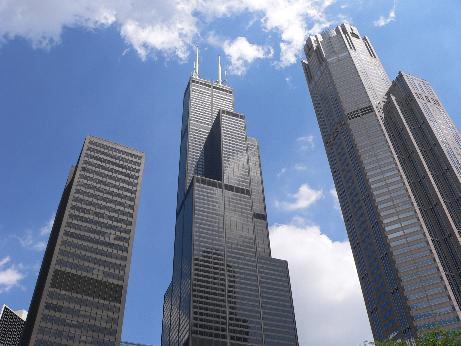 Sears Tower (center) |
After the race, we drove about 180 miles (289 km) back to Chicago and checked in to the Sheraton Suites located in Elk Grove Village. The next day, we found a rather expensive parking garage (just missed the "Early Bird Special") and took the architectural boat tour on the Chicago River. This turned out to be my favorite thing to do in Chicago. The weather was beautiful and the buildings, both old and new, were spectacular. It was like floating through an outdoor art gallery. The guide on the boat gave us all the details of the buildings including the dates of construction, architects and history. More about Chicago architecture later. |
After the boat tour, we walked to the end of the Navy Pier which juts out into Lake Michigan. The Navy Pier has a giant Ferris wheel, the Smith Museum of Stained Glass, the Crystal Gardens which is a one-acre glass atrium, a beer garden and several places to eat. We had lunch at the Billy Goat Tavern on the Pier.
The original Billy Goat Tavern located downtown is the restaurant that inspired the skit on Saturday Night Live where the cook played by John Belushi yells: "Cheezboger, cheezboger, cheezboger, no fries, cheeps, no Coke, Pepsi!" The cook there had that routine down - made you want to order fries just to hear him say it.
From the Navy Pier, we walked on North Michigan Avenue from the landmark Wrigley Building to the famous old Gothic Revival-style Water Tower built in 1869 and Pumping Station built in 1866 both structures two of the few buildings to survive the great fire of 1871. This section of North Michigan Avenue is known as the "Magnificent Mile" for all its famous stores and buildings. We ended up at the Pizzeria Uno Tavern for Chicago-style deep dish pizza and beer.
|
The next day, we parked at the Grant Park garage, walked around Millenium Park seeing the interactive Crown Fountain and the untitled sculpture (unofficially called Cloud Gate) which looks like a giant chrome kidney bean and weighs 110 tons (100 metric tons). Also in the park is the Jay Pritzke Pavilion with its distinctive band shell framed by huge folded ribbons of stainless steel, several gardens and the peristyle in Wrigley Square. We then walked to Grant Park to see the Buckingham Memorial Fountain, one of the largest fountains in the world. It has 133 water jets and the center jet shoots water 150 feet (49 m) high. |
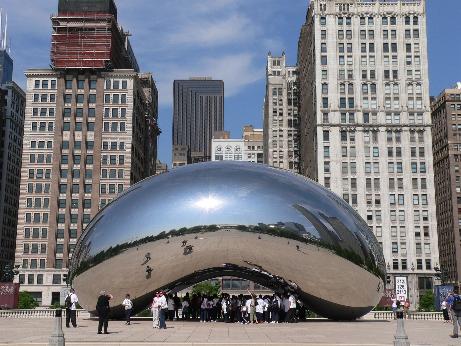 Millenium Park: "Cloud Gate" |
From Grant Park, it was a short walk to the Art Institute of Chicago, one of the greatest art museums in the U.S. It houses the largest Impressionist and Post-Impressionist collections outside France so Kathy got to see many paintings by her favorite artist, Claude Monet. I was really looking forward to seeing Grant Woods' American Gothic but every trip has to have some disappointment and this was it for me as this painting was on loan to the National Gallery in Washington, D.C. Oh well, a good excuse to go back to Chicago again.
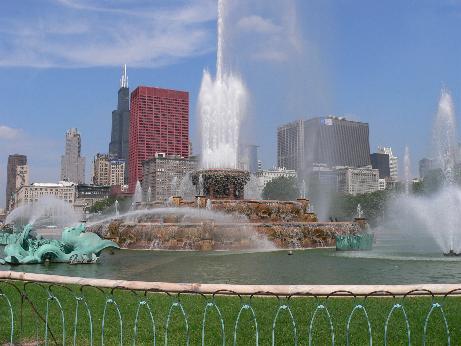 Grant Park: Buckingham Fountain |
After spending about four hours in the museum, we walked a few blocks to see the Reliance Building, completed in 1895 and at 14 stories tall, one of the early steel-frame skyscrapers. About this time, the sky opened up and started to pour. Our umbrellas weren't keeping us too dry so we waited it out in the historic Marshall Field Store. After the rain stopped, we drove to Astor Street named for German-born fur tycoon and real-estate magnate John Jacob Astor. We did a self-guided walking tour to see the famous houses of various architectural styles located there. Then we drove around Lincoln Park seeing several statues including one of Abraham Lincoln by Augustus Saint-Gaudens. |
It was now time to head toward Wrigley Field to see the Cubs take on the Cincinnati Reds. Historic Wrigley Field with its ivy-covered outfield walls is the second oldest major league baseball park after Fenway Park in Boston. During the second inning, the sky opened up again (luckily our seats were under the upper deck) and the grounds crew quickly rolled out the tarp. After a 61 minute rain delay, play resumed. Former Cub great Ernie Banks sang Take Me Out to the Ballgame during the seventh inning stretch, a tradition started by the late Cubs announcer, Harry Carey. The Cubs went on to win the game 8-3.
 The Friendly Confines of Wrigley Field |
We noticed the price of parking, food and drinks were much lower there than other ball parks we have been to and it seemed like everything was more traditional with less gimmicks - the way baseball should be. It was a great memorable experience.
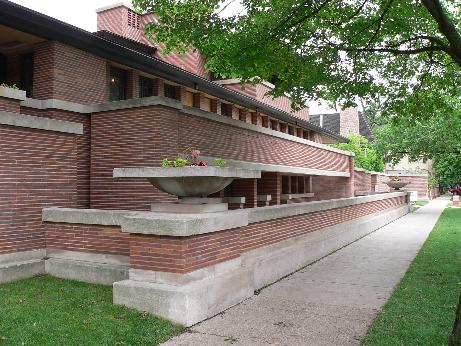 Hyde Park: Frederick C. Robie House (1910) |
The last day of our trip, we took a short ride to just across the border of Wisconsin and then came back along Lake Michigan. We passed through a really nice exclusive neighborhood and ended up in the south Chicago neighborhood of Hyde Park to see the Frederick C. Robie House, Frank Lloyd Wright's world-famous Prairie-style masterpiece completed in 1910. The house is being restored at a cost of $8 million dollars and it will take ten years to complete. The Prairie-style houses Wright designed were a radical design for their time with their horizontal lines, art-glass windows and open living spaces. |
Besides taking the guided tour of the Robie House, we walked around the neighborhood seeing the University of Chicago, the Rockefeller Memorial Chapel and the Midway Plaisance from the 1893 World's Columbian Exposition. From Hyde Park, we drove back to Midway Airport to catch our flight back home.
|
A little more about the famous architecture of Chicago. In addition to the buildings I previously mentioned, we saw the 110-story Sears Tower (tallest building in the U.S.) and the 100-story John Hancock Center building. We saw the 36-story Gothic-style Tribune Tower built in 1922 with flying buttresses and over 150 stones and artifacts from around the world (Great Wall of China, Great Pyramid of Cheops, Fort Sumpter, etc.) imbedded in its exterior. New York City architects John Mead Howells and Raymond M. Hood won the $50,000 first prize offered by the Chicago Tribune in an international competition to design the most beautiful office building in the world. On the river cruise, we saw the huge Art Deco-style 25-story Merchandise Mart built by Marshall Field and Company in 1931and later sold to Joseph Kennedy. It's still the largest commercial building in the world. We also saw a new 92-story tower being built by Donald Trump and many buildings designed by Louis Sullivan, Frank Lloyd Wright's mentor and boss before they had a falling out. We probably took 100 photos just of buildings. |
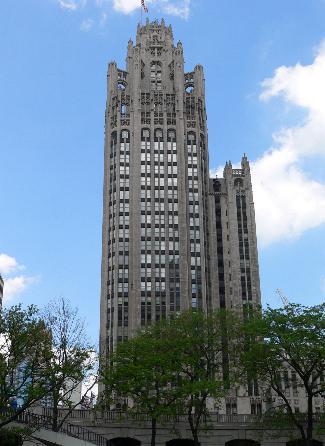 Tribune Tower (1922) |
On previous trips to Chicago, I saw the Field Museum, the Museum of Science and Industry, the observation decks of the Sears Tower and John Hancock Center and went to Buddy Guy's Legends bar in the South Side. While we saw quite a lot on this trip, there is still so much more to see including the Adler Planetarium, the Shedd Aquarium, the Chicago Theatre, more museums and many more new and historic buildings. We'll definitely be going back to the Windy City someday!
![]()